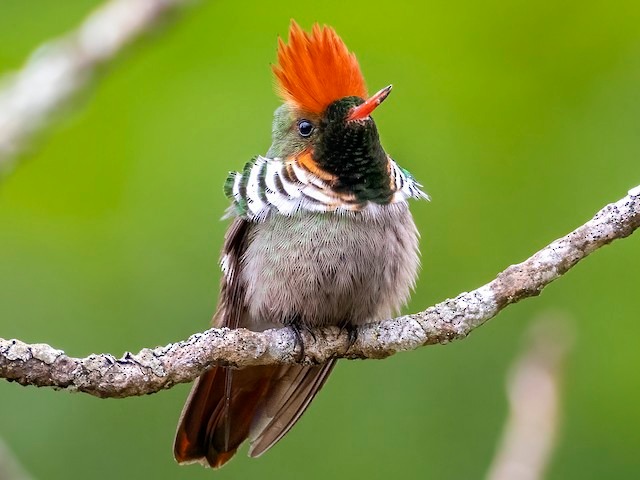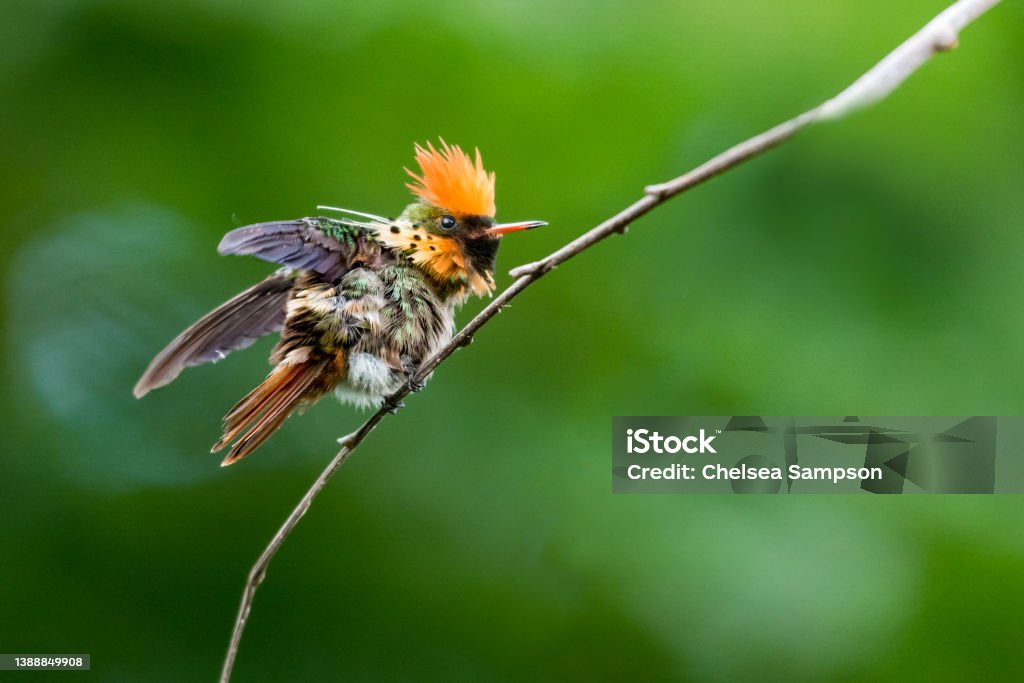In the world of hummingbirds, a family already known for its jewel-like beauty, there are some that simply defy belief. And then, there is the Tufted Coquette (Lophornis ornatus).
This bird is not just beautiful; it’s ornate. It’s a creature so small and so extravagantly decorated that it looks less like a bird and more like a tiny, magical flying ornament. Often mistaken for a large bee, this minuscule marvel from South America is a breathtaking example of nature’s artistry.
Here’s why the Tufted Coquette is, without a doubt, one of the world’s most beautiful hummingbirds.
1. The Unbelievable “Tufts” and Crest
The male Tufted Coquette is the one that gives the species its name, and he is a masterpiece of avian adornment. He is decorated with two distinct, spectacular features:
- The “Fiery” Crest: He sports a spiky, coppery-orange crest that stands straight up, resembling a tiny, fiery mohawk. This crest catches the light and seems to glow.
- The “Tufts” (or Coquette): This is the real showstopper. Exploding from the sides of his neck are long, extravagant cheek-tufts (or “frills”) of the same coppery-orange, but each feather is tipped with a brilliant, iridescent green or black spot.
When this tiny bird fans out its crest and tufts during a display, it transforms from a tiny bird into a dazzling, star-like creature. This is all accented by a glittering green throat, a bronze-green back, and a clean white band across its rump.
2. It Is One of the Tiniest Birds on Earth
Part of the coquette’s charm is its almost impossibly small size. This bird is a true miniature.
- Size: It measures just 2.6 to 2.8 inches (6.6-7 cm) long, from the tip of its bill to the end of its tail.
- Weight: It weighs around 2.3 grams.
To put that in perspective, a single U.S. penny weighs 2.5 grams. This is a bird that is literally lighter than a penny. Its flight is often described as “bee-like,” and at a glance, it’s easy to see why.
3. A Bird of Two Extremes: Male vs. Female
The Tufted Coquette is a stunning example of sexual dimorphism, meaning the male and female look completely different.
- The Male: He is the ornate show-off, covered in his crests and jewel-toned spots. He is designed to be seen.
- The Female: She is a model of elegant understatement. She has no crest and no neck tufts. She is mostly bronze-green on her back with a warm, reddish-brown (rufous) throat and a pale belly.
This dramatic difference serves a critical purpose. The male’s flashiness is for attracting a mate, while the female’s more subdued, camouflaged colors are essential for keeping her and her tiny, walnut-sized nest hidden from predators.

4. A Specialist of the Treetops
You won’t find the Tufted Coquette deep in the dark jungle. It is a specialist of the forest edge, open savannas, and even gardens.
- Habitat: It lives in northern South America, found in Venezuela, Trinidad, the Guianas, and northern Brazil.
- Diet: It survives on a high-octane diet of nectar, using its tiny, short bill to feed from small, delicate flowers (especially those from Verbenaceae and Rubiaceae plants). It also expertly snatches tiny spiders and insects from the air to get protein.
It spends most of its life in the canopy, a tiny, glittering spark of energy darting between blossoms.
Quick Facts: The Tufted Coquette
- Scientific Name: Lophornis ornatus
- Size: ~2.7 inches (6.8 cm)
- Weight: ~2.3 grams (Lighter than a U.S. penny)
- Habitat: Forest edges, savannas, gardens, and coffee plantations.
- Range: Northern South America (Venezuela, Trinidad, Guianas, Brazil).
- Key Feature: The male’s spiky coppery-orange crest and spectacular, black-spotted neck tufts.
A Tiny, Flying Masterpiece
The Tufted Coquette is a perfect example of how nature can pack an astonishing amount of beauty and attitude into the smallest possible package. It’s not just a bird; it’s a tiny, living jewel, a flying work of art that proves the most beautiful things often come in the tiniest sizes.
Have you ever been lucky enough to see a coquette hummingbird? Or is this tiny marvel now on your bucket list? Let us know in the comments!


